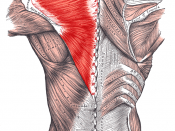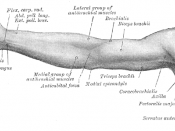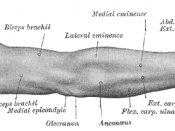A Kinesiological Analysis of the "Barbell Squat"
Step 1. Description of the movement
A. Starting position
Place your feet flat on the floor. From a rack with the barbell upper chest height,
Position the barbell over your Trapezius muscle not over your neck. The bar should be
Placed as far back as possible on the traps for the weight to be distributed properly
For safe execution. Next you would place your hands with a supinated grip around
The bar and hold it comfortably so its stays stable. Next your would thrust your hips
Forward and pull abdominals in and keep your lower back slightly arched. You want to
Try to keep your knees over your toes at all times to stay inline. You also want to have
Your heels directly under the bar.
B. Application of force-first phase
In a controlled manner slowly lower yourself (hips and butt first) down till knees and
Hips form a 90 degree angle and thighs are parallel to floor.
When desending it is important
To keep back very slightly arched.
C. Application of force-second phase (power phase)
In this phase the most power is generated because the legs are pushing against the resistance
To get back to the starting position. In this phase the squatter would push up off his heels
Until they return to the starting position.
Step 2. Purpose of movement
The purpose of the squat is to lower yourself to a position in which you could push
Against resistance to effectively work the thigh area with extreme emphasis on the
Quadriceps. The squat is also the single best bodybuilding movement because of
So many muscles are used in the squat.
Step 3. Classification of movement
Body movements which are involved are translatory. Because the path of the squat
Goes from point...


